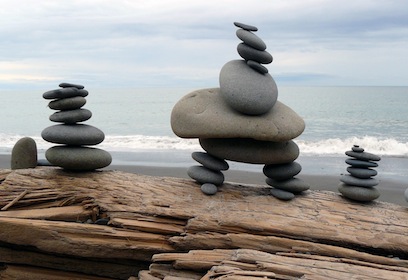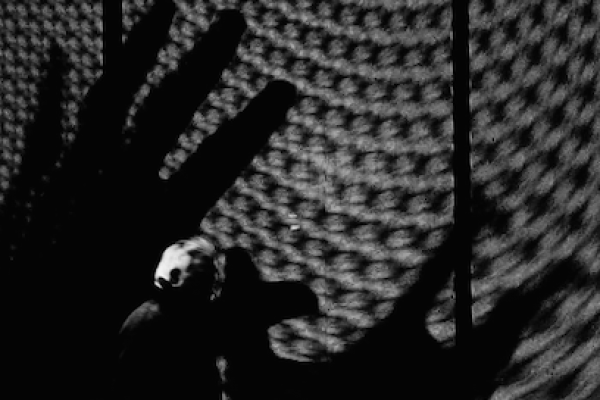When I was in seventh grade and had to walk what seemed a long mile to school, I would sometimes choose a pebble in the road and kick it along with me for several blocks, just to amuse myself. At some point en route I would tire of the game and leave the pebble behind. But by then I had adopted the pebble and taken it into my heart. So as I walked on, I wondered whether I had abducted it from home only to abandon it among strangers, or brought adventure into its boring stone existence. It was only a pebble, I kept reminding myself, but each discarded pebble taunted my adolescent self with the hope that I could make a difference to somebody, at the same time as it haunted me with the power of my own arbitrariness. I’m sure that’s how my pebble-picking career started.
Put me in a pebbled place and I can’t resist picking. On summer hikes I pick stones from river beds where I stop to swim, and from mountain trails, even when it means packing a stone uphill and back down again. I pick pebbles as souvenirs of foreign places and of my own past.
For all my pebble picking, though, I’m not a collector. I have no desire to acquire prize specimens, build a complete collection, or chalk off another one on my life list. I don’t identify, label, or record my finds. I don’t even keep them forever. I pick for the pleasure of choosing. In The Nearsighted Naturalist, Ann Zwinger says that when she picks beach pebbles, she is on a quest for “perfection” of pebble. I am not in search of perfect stones. I am in search of merely good ones. My quest is just as elusive, though, for I have to make up goodness as I go along.
My selection process always begins in the same way. I come upon profusion, and before I’ve finished taking in the multiplicity of it all, I notice something distinctive about the rocks in this place. Usually it’s color.
Atop Sally Mountain in Jackman, Maine, pink granite stands out on a sunny day. At the edge of Roaring Fork River in Aspen, Colorado, I am drawn to red, that deep brown, desert-sandstone color that coats the mountainsides and makes the grayish vegetation look greener than it otherwise would to my New England eyes.
Before I even register what colors I have decided to ignore, I select a shape or size within my chosen color. On Sally Mountain, I am taken with the way pieces of the granite dome seem to shear off in slices, so I choose a perfect rectangular slice, as if to take home not only a piece of mountain but a geological instant as well. In Aspen, I pick a handful of tiny, smooth, oval red ones, hoping to pocket the essence of river stones’ rounded form. While I am crouched down inspecting red pebbles, my eye catches a chunky gray stone with exuberant turquoise patches. It has nothing to do with my growing round red collection, but I like it and I want it, want it for its utter difference and flamboyance. I like a rock that has the temerity to stand out, as much as I like the solid citizens who define the character of a place.
One summer, after my husband Jim and I had vacationed at Lake Champlain, I made a small patio out of the shoreline’s gray shale stones, so distinctively striped with syrupy white lines of calcite. I had only enough stones to cover a small area, so the next time we went to Lake Champlain, I recruited Jim as my assistant. “How do you choose?” he asked me. “What makes a good one?”
I wanted to answer with Justice Potter Stewart’s definition of obscenity—I know it when I see it—but that wouldn’t bring Jim into the spirit of this enterprise, and besides, he had hit upon a question that had been troubling me for a long time. Just how do I decide that a stone is worthy of coming home with me? Earlier that day, I had been reading Amy Demarest’s This Lake Alive!, a handbook for teaching children about the Champlain Basin. In one exercise, Demarest asks her students to choose “ten excellent facts” about Lake Champlain. Not just any “true piece of information,” she admonishes, but “really good facts.” When Jim asked me for guidance, I had no more idea what made a good stone than a good fact, but I had a sneaking suspicion that it was the same force, whatever it was.
I like a rock that has the temerity to stand out, as much as I like the solid citizens who define the character of a place.
On the shores of Lake Champlain, I’m captivated by stripes, but how do I explain to someone else what makes good stripes? I like the simplicity of a single stripe tied around a stone like a ribbon on a gift. Sometimes I admire the way a white stripe edges a black rock, like piping on an upholstered cushion. I like multi-stripes, sometimes parallel, sometimes divergent, sometimes crisscrossed. And I especially like snaky white veins. I like them for their freewheeling sinuosity and because they seem so improbable. I’ve read that calcite and quartz veins form as water seeps into the cracks of ledges and carries tiny mineral deposits with it. Thus, the cracks serve as molds for stripes, but I’m still puzzled by how the jagged lines of fractured rock can produce smooth, graceful curves.
On that day when I was called upon to articulate my standards, I told Jim some of these thoughts, then quickly assured him that it was his prerogative to pick what looked interesting or just appealed to him. I said that since I was looking for patio stones, flat would be good, but within that parameter, it was up to him. “Just find me some really good stripes,” I said.
Then I knelt down and got straight to work judging goodness, as I always do—whimsical, arbitrary, and unthinking. I lit upon a stone with wonderfully wavy stripes, so I decided to look for others like it. I found one with complex curvy stripes on its upper side, but underneath, there was a rough notch where I wished it to be smooth and rounded. I briefly considered whether to overlook the defect—a defect wholly of my own making, mind you—but by then I had forgotten my complicity in the goodness and badness of stones. I’m not alone in my tendency to blame stones for failing to meet my standards. “Most pebbles show their best side, their promise of perfection on top, hiding their flaws in the sand,” Zwinger complains, as if pebbles are willfully deceptive.
Sometimes I am in a forgiving mood and let the defect slide, or I welcome the defective stone into my collection as one of such outstanding merit on the stripe dimension that a little nick on the form dimension amounts to nothing. I may even broaden my standards, finding virtue in what I now define as “character.” With a flick of a mental switch, I make oddness into goodness.
Other times I am merciless when I decide to pass on a specimen. Sorry, chum, not good enough for me. It’s then, when I replace a stone after having picked it up, turned it over in my fingers, and considered its virtues, that I get qualms. I wonder whether it feels rejected. Not that I believe a stone feels anything, but might I have sent a tiny ripple of rejection through the cosmos? That’s when I grasp that pebble picking is moral work.
In Family Bonds: Adoption and the Politics of Parenting, Elizabeth Bartholet writes about adopting her son Christopher. After years of anguish and investigation, she is finally in an apartment in Lima, and her Peruvian adoption lawyer hands her the baby the system has somehow picked out for her.
In the adoption world, suppliers avoid letting parents pick out their own babies from rows of basinets, although the assignment of babies at the end of the long adoption ordeal masks just how much picking parents do as they tick off their preferences for race, nationality, gender, age, and medical status. Bartholet, a professor at Harvard Law School, is not one to be coerced into a contract unknowingly, and she has given her adoption lawyer to understand that she wants to see more than one baby. “I don’t like this business of choosing a baby,” she explains to her readers, “but if there is to be a choice, I want it to be mine.” During the first phone call of this baby transaction, when the lawyer had offered to “hold” a boy several months old for her—the baby handed to her in the apartment—Bartholet had confided her hopes for a newborn. The lawyer had immediately offered her the choice of another baby due to be delivered the next day. Now in Lima, Bartholet makes clear that she still wants to see the newborn.
Around midnight, Bartholet, with first babe in arms, is whisked to another apartment and served coffee as though she is there for a casual social call.
Somebody removes the baby from my arms and takes him off into a back room. That person reappears with a newborn wrapped in a blanket and deposits this baby in my lap. I sit looking down at the tiny sleeping face of the child born just after my first call from Cambridge. There is no agony of choice. The first baby is already mine, although I did not entirely realize it until this moment.
Bartholet briefly considers adopting both babies but thinks better of it. Still, she has trouble giving the second baby back. “How do you say that you want to return a human being without its sounding like a Bloomingdale’s transaction? How do you hand a baby back without feeling that you are rejecting it, and how can you reject a helpless creature that lies trusting in your arms?” She stands up and holds the baby out to be taken from her. “There are tears on my cheeks as he is removed,” she writes. In that moment of choice, she has experienced the exhilaration of bonding with a baby and the pain of relinquishing one. She has also learned that choice, the modern American substitute for the idea of freedom, can be terrible as well as liberating.
I think that is why I still pick pebbles and bring them home. It’s good practice for the soul, a warm-up for the awesome responsibilities that come with having to choose among people instead of pebbles.
But that’s not the only reason: I also pick to exercise my faculty of classification. I rarely take just one stone, for I need several in order to fill the mental category I unconsciously design as I pick. Without multiples there can be no sameness, no display of the original virtue for which I selected (stripes). Nor can there be difference. Without multiples there can be no contrasting categories of belly stripes and edge stripes, say, or wiggly stripes and straight ones. My idea of perfection is a community of stones, not a lone specimen so isolated that it has no hope of standing out, yet so perfect that it has nothing in common with any others.
My selection practices are not entirely cozy, though. I am hardly impartial. I judge, I play favorites, I exclude from my company of stones. The utter impetuousness of my decisions boggles my mind. One minute I’m savoring variety, the next minute I’m narrowing my vision to one kind, and soon to one kind of a kind.
And by then, my mental discards might as well not exist. I have transformed the landscape with nary a bulldozer or stick of dynamite.
• • •
Jane Elliott was teaching elementary school in Riceville, Iowa, when Martin Luther King, Jr. was assassinated. Her white pupils had never met a black person, but they told her quite confidently that black people belong in a different category than white people. Blacks were smelly, dirty, dishonest, and dangerous.
Elliott devised a now-famous exercise to show her students firsthand what prejudice and discrimination feel like. She told her class that blue-eyed people are inferior to brown-eyed, that they are stupid, lazy, and untrustworthy. She changed a few classroom rules, giving brown-eyed kids extra recess, treats, and special rights, but otherwise, she did not instruct either group on how to behave. Within two hours, the children replicated racism in all its ugliness. Formerly outgoing and self-confident blue-eyed children became frightened, withdrawn, incapable of performing school tasks they’d been able to do the day before. The brown-eyed children excelled not only at reading and arithmetic, but also at lording it over their blue-eyed classmates. They reveled in their newfound status while they taunted, bossed and disdained their newly discovered inferiors. The blue-eyes grew dejected and demoralized as the brown-eyes sucked all the zest and pride unto themselves.
Our brains are hard-wired to react to new perceptions with one distinction: dangerous and bad, or good and safe.
Elliott’s life was transformed by the experiment. She was nearly run out of town for being a “nigger lover.” Her children were threatened and spat upon, and her father’s store was boycotted. Yet she repeated the exercise with each new class and launched a crusade against racism by taking the exercise on the road and demonstrating it on national television. She suffered much abuse for her work, but like a stone pulled downhill by gravity, she couldn’t stop.
Elliott saw the urge to discriminate and dominate barely below the surface, waiting for the slightest opportunity to express itself. She watched, horrified, as her disparaging remarks about blue-eyes opened a tiny crack into which the children deposited their particles of fear and hatred. She watched how those minuscule deposits hardened, widening the crack into a great divide. Elliott, to her credit, did not interpret the process as embedded in human nature. She chalked it up to learning and devoted herself to unteaching racism.
But might Elliott be wrong? According to the new cognitive science, our brains are hard-wired by evolution to react to every new sensory perception by making one distinction: Is the situation dangerous or not? As Daniel Goleman explains in Emotional Intelligence, the fundamental circuit of our ability to think is a binary switch in the most primitive part of the brain. The switch makes us categorize: Poisonous or edible? Predator or prey? Good or bad? Unlike the lower animals, we did evolve higher cognitive powers and the capacity to empathize, but we still get to those more nuanced rational and emotional forms of thinking by starting from that most primitive of moral judgments: dangerous and bad, or safe and good. So might discrimination in fact be an element of human nature? Is that why, when I am picking rocks, for God’s sake, I zoom from same/different to good/bad to keep/reject? Is that why it’s so hard to let a rock be just itself in whatever rocky way it happens to be?
The compulsion to discriminate and categorize is at the heart of nature study. The core skill of naturalists is called “keying”: specimen in one hand, classification guide in the other, naturalists name their specimens by noticing some features and ignoring others, comparing with the key, back and forth, same or different. From there, it’s all a matter of assignment: name to specimen, specimen to group. Professional naturalists are not the only ones driven to key. Classificatory field guides are among the most popular nature books around. What drives this urge to key? Zwinger, who collects insects more seriously than she collects pebbles, writes that when she finally keys an insect, she feels she has “put in another piece of the puzzle that makes up this place and time.”
Whenever we enter a new landscape of people or place, its vastness and unfamiliarity is disturbing. We don’t know how we fit in. We can’t begin to relate to the whole undifferentiated mass of it. Maybe we compare and select to fit ourselves into the puzzle and to make ourselves at home. We send out a mental charge and form a union with some small piece of the vastness, like walking into a party and scanning the room for someone we know and can talk to. In one stroke of classification, we define ourselves and others as members of a safe community.
What I still can’t fathom, though, is the power of our own categories to control us. We make up the rules out of thin air and the next you thing you know, we believe in their rightness. We execute the rules faithfully, as if our lives depended on it.
That is finally why, fathom or not, I have hope for humanity despite the conclusions of evolutionary science that we are still beholden to our primitive brains. Maybe our brains are pure products of natural selection. Maybe we think the way we do because those patterns of thought kept us alive and going strong. Ecological niches selected us and, oh, aren’t we the mighty ones.
But unlike the niche that knows not a whit about who or what it selected, unlike the crack in the ledge that can never know whether it is filling up with quartz or calcite, we humans can know that we made up the categories into which we pour one another like molten metal into molds. And because we can feel our creative powers as we sort and classify, we can transcend categories, too. A lawyer from Cambridge can cry for a baby in Peru. A teacher can recoil from the devastation of a simple categorical gesture. And I can ache for a pebble.
Note: This story originally appeared in the May/June 2013 print issue.








